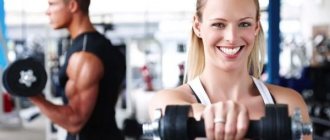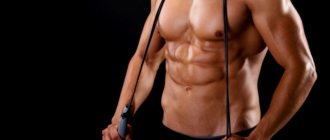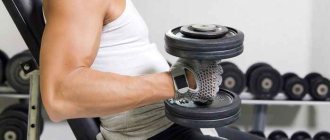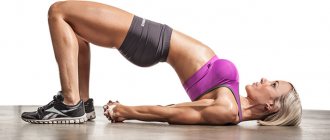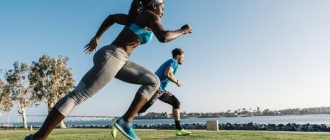The main advantage of the method is the accessibility of classes for every person. With the help of a group of exercises, each person can achieve high levels of endurance and muscle growth at home.
Developing muscles through systematic repetition of a set of basic exercises that are included in bodyweight training helps thousands of people every year to get their bodies in order . The main advantage of the method is the accessibility of classes for every person. Some exercises require additional equipment, such as dumbbells or a chair, however, at first this is not the most important thing. The training complex can be fully performed without special equipment.
Bodyweight training program for beginners
A bodyweight training program should begin with the most energy-intensive and difficult leg exercise.
Because in reverse order the strength may not be enough for them. 1. Bodyweight pistol exercise
Is it possible to pump up with your own weight? Your muscles don't know whether you're shoulder squatting, leg extensions, or single-leg squats. Don't tell your muscles what you are doing and then they will start to grow. When performing the exercise, distribute the body weight and try not to stand on your toes. If it's easy for you, just go a little slower.
Another nuance is holding your breath. In the first exercise, the anterior thigh muscle was more involved; in the next exercise, we will shift the load to the back of the thigh and buttocks.
2. Lunge exercise
The core muscles will also be involved if you do not have a very developed sense of balance or you have not trained for a long time.
3. Exercise “lateral lunges” 4. Exercise “glute bridge” 5. Exercise “wide grip push-ups” Provided the perfect technique and correct perception, most of you will forget about such numbers as 40.50 repetitions. At 15.20 repetitions, the chest will begin to burn and acidify. Because with a wide grip, the chest muscles do not relax.
6. Exercise “narrow grip push-ups” The triceps extends the arm at the elbow, the grip should be narrow. Ideally, the hand comes to the shoulder.
7. Exercise “imitation French press” Next, we move on to the final exercise on the back.
8. Exercise “pull-ups with a classic wide grip” The main load is on the latissimus dorsi muscles.
9. Exercise “reverse close grip pull-ups” The best exercise for biceps. All exercises are performed in 4 sets of 12 repetitions. Depends on your physical fitness. Particular attention should be paid to the ideal execution technique. 1-2 minutes of rest between sets, 2-3 minutes between exercises.
Introduction[edit | edit code]
Looking into any gym anywhere in the world, you will see a large number of steroid musclemen with a pile of muscles under an open T-shirt, who, boasting of being eight inches (yes, with delight, as much as EIGHT INCHES! 2.54x8 = a whole 21 (!!!) centimeters! !!) biceps, can easily squeeze a heavy barbell.
Are they really that strong?
- How many of them can use their athletic strength?
- How many of them can do twenty push-ups on one arm?
- How many of them have such a flexible, strong and healthy spine that, bending backwards, they can reach the floor?
- How many of them have strong enough hips and knees to do single leg squats?
- How many of them can do pull-ups with one hand?
The answer is simple:
Almost no one.
Simple bodyweight exercises are beyond the capabilities of many modern bodybuilders. However, the image of a jock as a model of strength, physical beauty and health has been strengthened in people's minds.
The pumped up body of a bodybuilder has become almost a standard. From my point of view, this is real madness. What difference does it make how many kilograms you can lift in the gym or on the machine? Can one be considered “strong” if he cannot lift himself up?
Gaining strength[edit | edit code]
Gym enthusiasts care only about their appearance, but not about their abilities. A person may have large, artificially pumped up arms and legs, but all this increased volume is muscle, while the joints and tendons remain weak. Ask an average bodybuilder to do a couple of deep squats on one leg - with his butt touching the floor - and his knee ligaments are likely to tear. As a rule, the strength that bodybuilders possess is not used for its intended purpose; if you ask one of them to walk on his hands, he will fall head first on the first step.
I don't know whether to laugh or cry when I see young people shelling out a fortune for gym memberships and home workout equipment in hopes of getting fit and fit. This is a real robbery! The fitness industry has convinced the world that sports and fitness are impossible without special sports equipment, which is sold or rented (in the case of a club membership) for exorbitant fees. And this is a tragedy, because almost every athlete who does not use steroids progresses very slowly in both muscle development and athletic ability.
To become truly strong, you don’t need barbells, cables, fancy machines and everything that the fitness industry and advertising pushes on you. You can become strong, muscular and tough like Hercules without any special equipment. To discover this power within yourself—the power of your own body—you need one thing: the right approach. Real art.
And such an approach exists. It is based on traditional (ancient) forms of training. With its help it is easy to turn from a frail boy into a steel fighter. This approach is called progressive calisthenics - the art of using the human body to maximize its physical development. Rhythmic gymnastics today is the basis of aerobics, cyclic training or endurance exercises. Unfortunately, this method was not taken seriously at first. But in the past, until the second half of the 20th century, all the strongest athletes in the world gradually became stronger with the help of rhythmic gymnastics - day after day, week after week, year after year.
The Lost Art of Bodyweight Training[edit | edit code]
Unfortunately, this approach is not taught in any gym in the world today. This art has been forgotten by many modern athletes due to the fascination with the latest training methods - from metal barbells to high-tech simulators. The art of rhythmic gymnastics has been overshadowed by fitness fads and fitness equipment manufacturers who want to sell you the right you are born with to exercise your body and soul.
Unable to withstand such an assault, the traditional art of gymnastics degraded and turned into physical education for schoolchildren. Nowadays, “gymnastics” includes push-ups, pull-ups and squats. These are all good exercises that, when repeated frequently, increase endurance, although they do little to build strength. A true master of the old school knows perfectly well how to develop his physical abilities and achieve real strength. Almost everyone who trains at the gym desperately hopes to build strength with a barbell or machine. I've seen guys train old school, and they were so strong that they broke steel handcuffs, easily broke wrought iron chains, and literally smashed brick walls to smithereens.
Do you enjoy this incredible physical strength?
In the pages of this book, I will try to teach you techniques that will allow you to achieve the kind of strength and physical perfection that will never happen if you train on machines. Only traditional gymnastics can transform your body, develop superhuman endurance and strengthen your flesh.
How I learned my craft while serving time[edit | edit code]
Fortunately, the old school system survived thanks to the efforts of people who did not have access to barbells or dumbbells, who had to survive in the inhumane conditions of colonies and prisons - where civilization is on the other side of the bars.
My name is Paul Wade, and unfortunately, I know all about life behind bars. I was first incarcerated in 1979 and spent nineteen (of twenty-three) years in prisons like Angola (also known as “The Farm”) and Marion, a hell built to replace Alcatraz.
I know more about the old school than anyone else. During my last sentence, I was given the nickname Entrenador, which means “coach” in Spanish. All sorts of young people came to me with a request to turn them into strongmen in the shortest possible time. I've gotten a hell of a lot of kudos, but the most valuable thing I've received is confidence that my technique works. I myself got to the point where I could do over a dozen handstand push-ups without support, a feat that not even Olympic champions can replicate.
I won the annual Angolan prisoner push-up/pull-up championship for six years in a row, even while working full time at The Farm (prisoners were forced to work until they were completely exhausted so they would be less of a "problem"). I was also third in the California Institutional Powerlifting Championships in 1987, despite never using weights in training (and only entering the competition to win a bet). For twenty years, my training system allowed me to be stronger and tougher than the vast majority of those psychopaths, veterans and other eccentric individuals with whom I had the good fortune to meet. Most of them were actively training. While their training methods and achievements are unlikely to be featured in trendy fitness magazines, ironically, some of the most impressive athletes in the world are ex-cons.
In prison, my “profession” became strengthening my body, building strength and keeping myself in excellent physical shape. I did not learn this art in a comfortable room surrounded by tanned musclemen and girls clad in spandex. I did not take the certification, having completed a three-week course, as is now customary for personal trainers. And, damn it, I’m not some scribbler with a fat ass who has never really sweated in his life, like those who write about fitness and bodybuilding in newfangled books. Moreover, I was not strong by nature. The first time I was in prison, just three weeks after my twenty-third birthday, I weighed only 68 kg, stood 183 cm tall and looked like a fire tower: lanky, thin, with underdeveloped twig arms and almost complete absence of any or physical strength. Having received several unpleasant lessons, I quickly realized that all prisoners play on the weaknesses of their fellow sufferers and intimidation is a bargaining chip in the hole into which I was brought. And since I had no intention of becoming anyone's target, I quickly realized that the easiest way to avoid becoming someone's target was to build muscle, and quickly.
Luckily, after a few weeks in San Quentin, I was transferred to a cell with a former Navy SEAL. He was in excellent physical shape and taught me the basics of gymnastics - push-ups, pull-ups and deep squats. Several months of training under his strict guidance increased my strength and helped me gain some muscle mass. Training in the chamber every day built up my endurance, and soon I was doing over a hundred repetitions at a time. But I stubbornly wanted to be bigger and stronger than anyone ever, and I tried to extract any information that would help me achieve my goal. I learned from everyone I could find—gymnasts, soldiers, Olympic weightlifters, yogis, wrestlers, and even a couple of doctors.
At that time, I did not go to the gym, but trained in the cell. I had nothing but my body. Training became an obsession for me - I immersed myself in this process. Six months of hard work gave me a ton of strength and weight, and after a year I became one of the strongest and most powerful guys in the prison. And all this thanks to the methods of the traditional gymnastics school! Unfortunately, the technique has been successfully forgotten in the world of freedom, but in prisons, knowledge about it is passed on by word of mouth, from generation to generation. In conclusion, there are not many options for training, no Pilates or aerobics classes for you. Nowadays there is a lot of talk about gyms in prisons, but believe me, this is a relatively fashionable trend and if there are gyms anywhere, they are extremely poorly equipped.
One of my mentors was named Joe Hartigan. He was seventy-one and in his fourth decade of a life sentence. Despite his age and many injuries, Joe continued to train every morning. He was as strong as a bull - he could easily do pull-ups on his index fingers and do push-ups on the thumb of one hand. These were his signature tricks. He knew a lot more about actual training than most "experts." Joe trained old school before the world knew about dial-up barbells. At the time, the emphasis was on bodyweight exercises, a technique that is now more common in regular gymnastics than in bodybuilding or strength training. Thus, the bench press was performed not on a comfortable gym bench, but with large, heterogeneous objects - heavy barrels, anvils, sandbags and other “human” weights. This press developed qualities that cannot be achieved in modern gyms - endurance, tendon strength, balance, speed, coordination and incredible control.
Done efficiently, with full dedication and in compliance with all the rules, this type of training made athletes incredibly strong.
In 1930, in St. Louis, Joe trained with one of the world's most famous strongmen, the Mighty Atom. Atom is a phenomenon in strength sports: he is only about 162 cm tall and weighs about 63.5 kg. Every day he performed such feats that modern bodybuilders nervously smoke on the sidelines. He broke chains, drove screws into pine boards and drove half a nail into a beam with his bare hands. Once in 1928, he held a plane taking off with the hair on his head! Unlike modern gym-goers, Atom was really strong and could use his strength in any, even the most ordinary life situation - he could easily change car tires without using a single tool - he simply unscrewed the bolts with his bare hands, then lifted car and put the spare tire on! In the mid-1930s, he was attacked by six angry longshoremen, and as a result of the fight, all six were sent to the hospital with injuries of varying severity. It’s good that he didn’t go to prison because of this, since he regularly practiced twisting steel bars, and did it as easily as if they were not steel bars, but hairpins. Like Joe, Atom did his tricks in the pre-steroid era and didn't need stimulants for his puffy muscles. Atom was incredibly strong and even at 80 years old he remained an unsurpassed strongman. During long breaks, Joe regaled me with stories about the world-class strongmen he knew and trained with during the Great Depression.
I was lucky to learn a lot about old school philosophy. So, Joe always emphasized that strength is gained only in training with your own weight, and all the athletes of the past knew this. Yes, they demonstrated their strength by manipulating various objects - barrels and nails, but in most cases their strength was based on control of their own bodies. In fact, Joe hated weights and dumbbells. “This is such stupidity - these barbells and dumbbells! - he told me during lunch. “You can achieve a much more impressive result using your own body.” The ancient Greeks and Romans trained this way - look at the statues from that era. They have such impressive muscles that no other jock has today!” And it is true. Just look at the sculpture of Hercules Farnese or Laocoon. The athletic guys who posed for these sculptures definitely had developed muscles and could easily win any modern bodybuilding competition. It should not be forgotten that the collapsible rod was invented only in the 19th century. If you still don’t believe me, look at modern gymnasts. These guys train exclusively with their own bodyweight, and many have physical characteristics that would make any bodybuilder blush.
Joe unfortunately died, but I promised him that his principles and wisdom would never die. They are presented in the book you are holding in your hands. Rest in peace, Joe.
From student to master[edit | edit code]
In recent years, I have observed more than once how some prisoners train in the yard (if there was one) with weights, while others train in their cell, without anything. For many of them, training is a religion, a way of life, and I have spoken with the vast majority of them - athletes of the highest class. Over the years, I have collected advanced techniques and valuable tips from them, which I later incorporated into my system. To be fair, I learned most of my knowledge about physical fitness in prison. Experimenting on myself, I did not rest for a single day, always translating the acquired knowledge into pain and sweat. And as a result, having eaten dog during training, I was always in excellent physical shape. Any incident I was involved in quickly collapsed - my power was explosive and dangerous. Over time, having learned the secrets of mastery, I lost the respect of my fellow inmates and even the prison guards. In the nineties, after the murder of two guards at Marion Prison, all prisoners were assigned to solitary confinement. To avoid potential problems, guards checked prisoners every forty minutes. Thus was born the joke that the guards, seeing me doing a series of push-ups, would come forty minutes later to check how I was doing.
In recent years, newly convicted prisoners have approached me almost every day with requests to teach them how to train in order to become strong and resilient in a short time. Everyone wanted to learn about the forgotten art - training without special equipment, because many of them, due to their prison status, were not supposed to lift weights, like veterans, in the yard.
So I became a trainer for hundreds of prisoners. The experience I gained from this was invaluable and allowed me to refine my system so that it was equally effective for different body types and metabolic levels. I noticed that the motivation and mental aspects of training vary greatly from person to person, so I had to quickly adapt my system to suit the individual needs of each of my students. Gradually, I polished the technology so that any sane person could use it, regardless of their level of training.
The book you are holding in your hands is mostly my secret “training manual” written in prison. It is the fruit of endless hours of training in proper training techniques. This is my brainchild. And it works. Should work! If I had not been able to train one of my guys to the maximum limit of strength and power, the matter would not have been limited to simply losing in competitions. Prison is cruel. Survival is the main goal of your stay in it. If you are weak, you are dead. All my charges are alive and well, for which I thank them very much.
Lights out![edit | edit code]
I could write an entire book about how power and reputation are key qualities for surviving in prison. Someday I will do it. But this book is not about prison life. This is a book about physical training. I have given several examples from prison life to show the brutal, isolated and yet traditional environment in which the old school system survived. This does not mean that you must necessarily find yourself in such conditions in order to train using this system. Not at all necessary! However, if my methods worked for people in the harshest and most inhumane conditions, then they will be no less effective for you.
They work!

